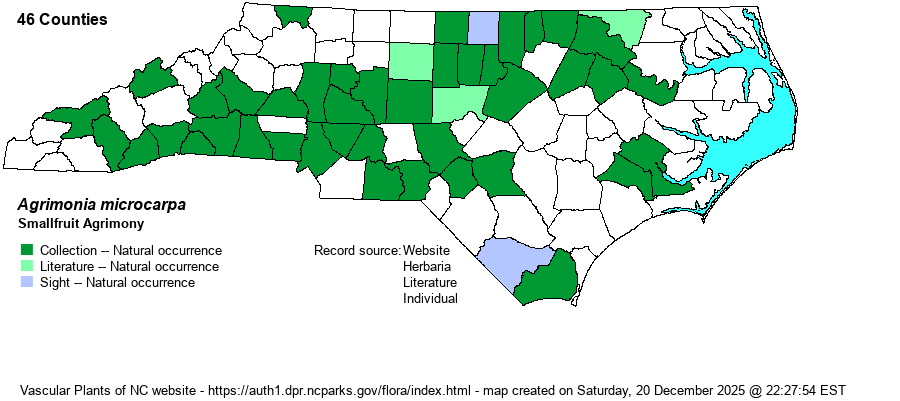| Author | Wallroth | |
| Distribution | Present over most of the Piedmont, and scattered over much of the Mountains. Also scattered over the western and central Coastal Plain, being absent from eastern counties. The absence of records from the northwestern Piedmont is likely an artifact of collection.
This is mostly a Southeastern species, ranging from PA south to northern FL and west to eastern TX, but absent from TN and KY. | |
| Abundance | Infrequent to perhaps fairly common in the Piedmont, except rare in the northwestern portions. Rare in the Mountains, and rare to uncommon in the Coastal Plain. This species is quite similar to several others, especially A. pubescens, and is likely under-collected. | |
| Habitat | This species grows in mesic forests, edges, and openings. It is normally found in upland areas, but does not usually grow in xeric, rocky, or sandy places. | |
| Phenology | Blooms from July to early September, and fruits from August to October. | |
| Identification | The genus Agrimonia has numerous species with distinctive leaves and flowering stalk, but the characters to separate many are quite technical, and biologists may have trouble keying them out. All have erect stems ranging in the vicinity of 3 feet tall, with alternate leaves that are distinctly pinnately compound, with small leaflets intermixed with much larger ones. Also, the inflorescence is a very long and slender spike-like raceme of tiny yellow flowers; these plants should be easily identified to genus level. In this species, the stem is fairly slender and reaches only to about 2 feet tall. It is quite hairy on the lower part of the stem. The leaves are mostly clustered toward the base of the stem, and the leaves have mostly just 3 large leaflets, (terminal and one set of leaflets on the side), along with small leaflets along the rachis. The leaflets tend to be quite obovate and rounded toward the tip, and they are quite velvety-pubescent below. This species is quite similar to A. pubescens, as neither have glandular stems and racemes, but that species has the stipules at the bases of the leaves toothed, but not deeply so, whereas A. microcarpa has deeply cut stipules into sharp teeth. Also, A. pubescens tends to have at least 5 large leaflets, as opposed to mainly just 3 in A. microcarpa.
| |
| Taxonomic Comments | This species was treated as a variety in RAB (1968), as A. pubescens var. microcarpa. However, most references, even older ones, do treat this as a good species.
| |
| Other Common Name(s) | None | |
| State Rank | S4 | |
| Global Rank | G5 | |
| State Status | | |
| US Status | | |
| USACE-agcp | | |
| USACE-emp | | |

